Lama Tsomo Offers Accessible Introduction
To Tibetan Buddhism in ‘Ancient Wisdom’ books
Written by: Jessica Larson
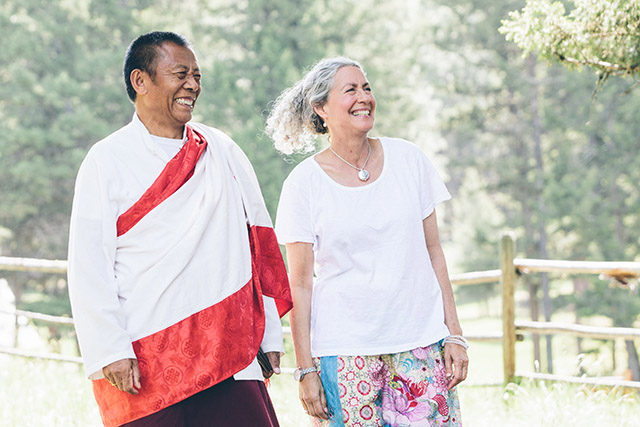
Tulku Sangak Rinpoche and Lama Tsomo have forged a deep and trusting bond, based on the dharma.
Photos by: Keegan Connell, Jessica Larson, Namchak Foundation, Namchak Publishing Company, Erika Peterman
Lama Tsomo, a Montana-based female lama in the Nyingma tradition of Tibetan Buddhism, has just published the second volume in her “Ancient Wisdom Series.”
Her new book, “Wisdom & Compassion (Starting with Yourself),” breaks down three foundational Vajrayana meditation practices that complement each other to promote happiness and well-being: Shamata, Tonglen, and Cleansing the Stale Winds. The book, with a forward by His Holiness the Dalai Lama, gives readers an opportunity to put Vajrayana wisdom into practice in an accessible way, guided by imagery of poses and positions.
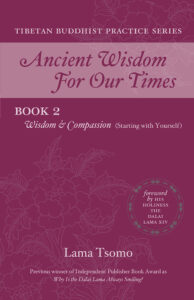
Volume 2 of Lama Tsomo’s Ancient Wisdom Practice Series: “Wisdom & Compassion (Starting with Yourself).”
The Vajrayana path features unique and powerful methods that Tibetan Buddhists believe bring about quicker results than other vehicles of Buddhism.
Through her Ancient Wisdom series, Lama Tsomo provides an accessible introduction for exploring the Namchak lineage and its ancient roots.
Taken together, the two Ancient Wisdom volumes offer practitioners an entry into the Vajrayana path of Buddhism. They also provide insight into Lama Tsomo’s own spiritual journey, her path to finding her calling.
The first volume, “Why Bother?,” introduces those roots and traditions, answering fundamental questions about Tibetan Buddhist practice.
Lama Tsomo, co-founder of the Namchak Foundation, is a former practicing psychotherapist, who trained for years under the tutelage of esteemed Tibetan master Gochen Tulku Sangak (Sang-Ngag) Rinpoche.
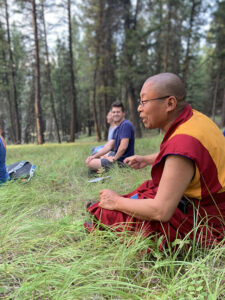
Namchak Khenpo Rinpoche Ngawang Gelek, a brother of Tulku Sangak, teaching at a retreat.
In 2005 Lama Tsomo, born Linda Pritzker, was ordained as one of the few female American lamas in Tibetan Buddhism. Her journey toward becoming a lama included spending three years in strict, solitary retreat under the guidance of Rinpoche, during which she progressed through stages of the Vajrayana path and became fluent in Tibetan.
Within Nyingma, one of the four schools of Tibetan Buddhism, lies the small lineage of Namchak, led by Tulku Sangak Rinpoche. Rinpoche also serves as the spiritual director of the Namchak Foundation and Retreat Ranch, near Hot Springs, Montana.
Starting in 2023 students will be able to study and practice at the retreat ranch under Tibetan masters, surrounded by the serene expanse of the Flathead Indian Reservation.
Lama Tsomo is dedicated to sharing the teachings of the Namchak lineage with Western students, in a style that is accessible, informal and often humorous. Her new book does all of these.
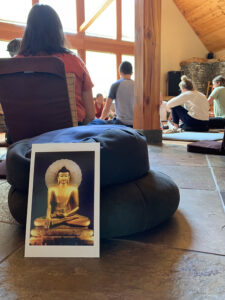
View from the cushions at a shamata retreat.
Vajrayana path teachings are offered only through qualified teachers (lamas) who carry particular lineages carefully handed down through the centuries.
There are hundreds of lineages associated with different regions and monasteries in the Vajrayana path. Many of these lineages trace back to Guru Rinpoche, who established Buddhism in Tibet, and to the Buddha, who began teaching in India more than 2,600 years ago. Each lineage of Tibetan Buddhism has distinct stories, teachings and ceremonies for achieving the goal of liberation from samsara.
Lama Tsomo is especially passionate about reaching young people and supporting those working for positive social change. She believes that through meditation practice, community, and retreat, students can gain greater happiness and meaning in their lives, and subsequently enact that meaning out in the world.
“Wisdom & Compassion: Starting With Yourself,” builds on her first title in the series, “Why Bother?,” by introducing readers to multiple forms of practice in the Namchak lineage. The book is an accessible guide for practitioners.

Lama Tsomo has completed the traditional Tibetan three-year retreat.
Here are the three areas of teaching in the book:
First, on the Buddhist path Shamata, or calm-abiding meditation, serves as the foundation for all other practices. It is a technique used to develop our power of attention and bring our coarse and subtle thoughts to a restful state.
Shamata can bring a powerful level of calm to the mind, so much so that one can rest for long periods of time without the slightest stirring of thoughts or emotions. In her book Lama Tsomo describes how by consistently doing this practice, she has learned more about the true nature of mind and how it works than in all of her years studying psychology.

A view of the beautiful Namchak Retreat Ranch, in western Montana.
Second, Tonglen, meaning “sending and receiving” in Tibetan, is a form of compassion meditation. In this practice, we basically imagine breathing in the suffering of others and breathing out our wish for their happiness. Through connecting with others (as a compassionate act), Tonglen helps us feel how we’re not separate from others.
Third, the practice of Cleansing the Stale Winds, or Lung Ro Sel in Tibetan, is the practice we do to increase our chances of really resting in still, clear, joyful awareness. In her book Lama Tsomo affectionately refers to this practice as the “Tibetan nose blow.” She describes how this practice can release the energies connected to the afflictive emotions (the three poisons): desire, aggression and ignorance.
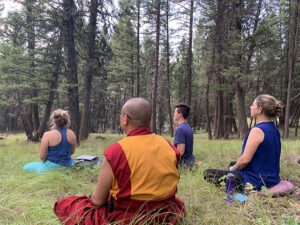
Namchak Khenpo Rinpoche Ngawang Gelek, with students during a summer retreat.
In addition to breaking down these meditation practices, Lama Tsomo in her book highlights the importance of sangha. The way the Namchak lineage focuses and cultivates sangha, by practicing in community, is unique. She writes that when people meditate in community, a deep connection is made that cannot be felt when meditating individually.
This is why the Namchak Foundation offers “Learning Circles,” where students come together in groups with family and friends, to practice meditation and to share how mindfulness is influencing their daily lives.

Tulku Sangak Rinpoche and Lama Tsomo share a laugh during a translation team retreat.
Namchak Foundation offers a variety of learning programs for early and seasoned meditators, whether they are looking to take their practice to the next level or to simply begin exploring the Vajrayana path. Namchak offers a number of free online resources, including e-courses and guided meditations on the Namchak YouTube channel, as well as individual teachings, small group learning, and virtual retreats.
In-person retreats at the ranch in Montana are expected to begin in the summer of 2023. People can also join one of Namchak’s signature Learning Circles online, or they can start a circle with other practitioners. In this case Namchak will provide them with the resources and support to do so.
Jessica Larson (she/her) serves as director of outreach and education for the Namchak Foundation and is passionate about sharing the practices and wisdom of Tibetan Buddhism with others. Practicing meditation and being in community light her up and keep her on track. Larson has worked with nonprofits throughout her career, and loves helping individuals and organizations develop meaningful work and community.
